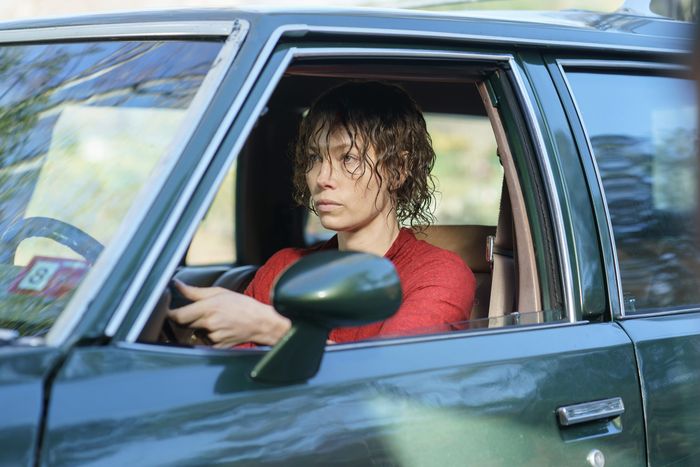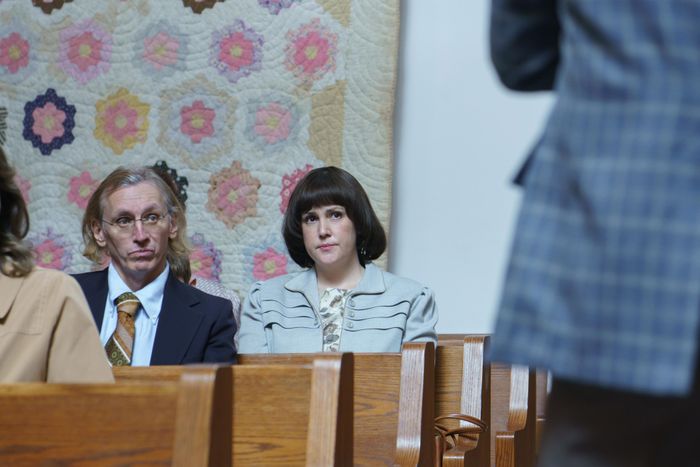
Candy is soundtracked by exasperated sighs. This five-episode Hulu miniseries about the gruesome 1978 axe murder of Betty Gore (Melanie Lynskey) and the involvement of her former friend Candace “Candy” Montgomery (Jessica Biel) in the crime coalesces around the sounds of the women’s dissatisfaction. In their flares and pageboy haircuts, these women are exhausted by their demanding children, irritated with their unfulfilling husbands, frustrated by the judgmental atmosphere of their small Texas town — and ultimately wary and suspicious of each other. But these characters are outlines with little filler, and the connective tissue between them and the surrounding community is missing. A broader observation about the reverberations and ramifications of this violence doesn’t materialize, and in its absence it creates a kind of anticlimax. Like those sighs, Candy feels evanescent, even weightless.
Created by Robin Veith and Nick Antosca, who previously worked together on The Act, Candy tells a similarly twisty story about hidden identities and the thin line between love and rage. Although not officially based on the book Evidence of Love: A True Story of Passion and Death in the Suburbs — which was optioned by HBO Max for Love and Death, 2022’s other limited series about this crime — Candy follows most of the broad beats recounted within Jim Atkinson and John Bloom’s 1983 true-crime classic: Vivacious housewife Candy Montgomery, bored after a decade of marriage to blandly nice Pat (Timothy Simons), decides to have an affair. Her target is fellow churchgoer and volleyball teammate Allan Gore (Pablo Schreiber), who is in a struggling, nearly lifeless marriage of his own to the matronly Betty. Betty is then killed in a horrifying way, and the town wants to believe that a drifter is responsible. No way someone they know could take an axe to this woman 41 times, chopping off half her face and leaving her infant daughter screaming in the next bedroom over. Could they?
That’s the story, and that’s basically how Candy, which premieres today on Hulu and drops a new episode each day until May 13, tells it. There’s no narrative twistiness here and no real obfuscation in terms of who is guilty. That isn’t to say that manufactured mystery is required for true crime, but what Candy lacks is a sense of why this story and why now. What does this incident tell us about the criminal-justice system and how it treats criminals of a certain race, gender, and social class? About the closed-ranks nature of the American South? About being a woman in America, aside from the fact that men can be trash and children can be a nuisance? That latter question is alluded to a bit in the series’ presentation of Candy’s and Betty’s domestic lives, but any sort of insight about the challenges of womanhood then versus now is absent.
Excerpts of Evidence of Love are available to read online, but doing so only delineates everything that Candy didn’t work into its character development or dialogue, world-building details that might have helped the series be more enveloping. Betty was a teacher before leaving that job to tend to her growing family; for how long did she struggle with what seems like agoraphobia and paranoia? Did Candy always want to be a housewife, or did her sense of adventure get tamped down at some point? How did Candy and Pat, and Allan and Betty, meet and fall in love? Candy boasts often of having the “best party house,” while numerous establishing shots show the Gores’ modest one-level rancher. Was there friction between the couples’ social status that worked its way into their relationship dynamics? In the weeks or months between when Candy was arrested and when she faced trial, what did she go through? How did the community interact with her family or with Betty’s survivors? Candy is so cut-and-dry in its linear movement from affair to murder to court that it denies viewers the context and texture needed to make this world feel established and lived-in. Placing us alongside Candy for the killing might be the series’ attempt to invite viewers behind a literal closed door, but the blood-drenched sequence is so staggeringly grotesque that it’s more repellant than immersive.
The framing of Candy is such a disappointment because Biel and Lynskey both do good work within it. Through the premiere’s desaturated color palette, odd angles, and a passing reference to Stanley Kubrick’s The Shining, director Michael Uppendahl establishes a pervasive dread, which is supported by the actresses’ contrasting performances. Biel has reinvented herself in this genre after the success of The Sinner, and she well conveys Candy’s breezy friendliness with an undercurrent of inauthenticity. The miniseries opens with a fourth-wall-breaking monologue from her character that is both Christian parable and self-aggrandizement, and her cool confidence while practicing a story about how second chances are for getting what you really want is an introduction to her layers of self-justification. A scene in which she’s showering Betty’s blood off herself and raises her hands toward the ceiling as if in prayer might be the series’s most unsettling.
Lynskey, meanwhile, makes Betty a kind of humanized Eeyore: a woman so sour and dour that it’s impossible to tell whether she loves her children or despises them, but whose girlishness comes through when her husband pays attention to her. Biel’s wide smile and the airy, sunny openness of her home contrasts well with Lynskey’s persistent frown and perpetually drawn curtains, and the series’ other production-design and costuming elements underscore how the women’s accessories and aesthetics set them in opposition to each other.
What’s odd, though, is how firmly the series aligns itself with Candy’s perspective and how it fails to interrogate her eventual explanation for what happened in the Gore home that Friday the 13th. There are standalone scenes for Lynskey as Betty throughout so that we can see her sternness with her children and the way she pleads with Allan to recommit himself to his marriage, but by the final episode, we don’t get any sense of how much Betty knew about Candy and Allan, how she would have reacted to Candy parenting her daughter, and what she could have said to Candy when the woman waltzed into her home. There isn’t much illumination of interiority here on Betty’s part compared with Candy, and historically, that’s all the jury got too. Candy got to present her side of the story, and there was no other.
The Staircase, HBO Max’s currently airing true-crime series about the death of Kathleen Peterson, achieves an inner life for its victim with myriad flashbacks to Toni Collette’s character at work, at home, at the gym, with her children, and with her friends — locations and situations that give Collette the space to work through her secrets, desires, ambitions, and regrets. If the supernatural and self-aware elements that Candy tosses into its finale as our last impression of Lynskey’s Betty were incorporated throughout the series, as The Staircase does with its memories of Kathleen, perhaps Candy would have also felt like it honored this woman and her life rather than solely gawking at her death. But a few sparse intertitles don’t provide an update on what happened to Betty’s parents or her children, nor do they provide much closure. Instead, Candy ends with the sense that it used Betty too, revictimizing her and flattening her for its purposes. “I’m the mother of your children, but that’s not all I am,” Betty says to Allan, but Candy makes clear whose story it’s more interested in telling through its name alone.
More TV Reviews
- Meghan Markle Pioneers New Frontiers in Unrelatability
- Marvel Won’t Let Daredevil: Born Again Live
- We Were Too Hard on Winning Time



